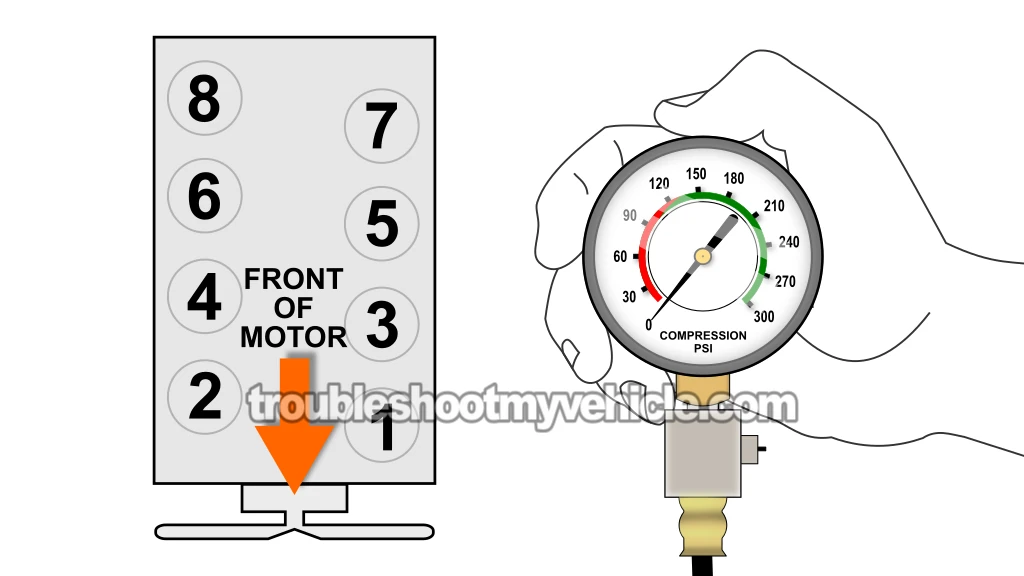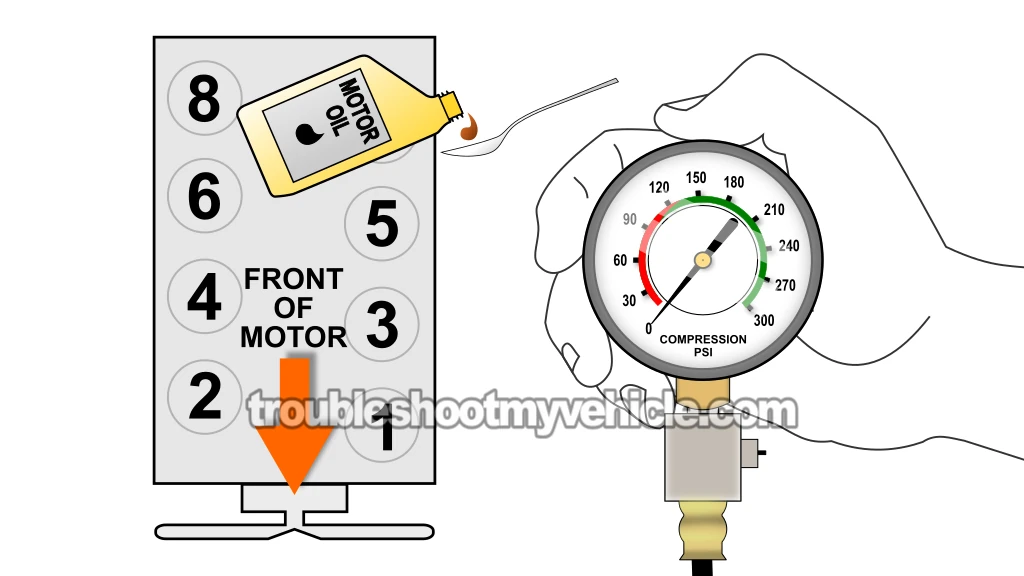
Testing the engine compression, on your 5.2L or 5.9L V8 equipped Dodge Ram pickup, is not as hard as people think.
In this tutorial, I'll show you how to do it and more importantly I'll also show you how to interpret the results of the compression test.
Why do an engine compression test? Well, it may help you to find out if the engine is shot and if this is the reason why it won't start or the reason behind your pickup or SUV's hard to diagnose misfire condition.
Contents of this tutorial:
APPLIES TO: This tutorial applies to the following vehicles:
- 1989-1993:
- Dodge Ram 150 Pickup 5.2L V8: 1989, 1990, 1991, 1992, 1993.
- Dodge Ram 250 Pickup 5.2L V8: 1989, 1990, 1991, 1992, 1993.
- Dodge Ram 150 Pickup 5.9L V8: 1989, 1990, 1991, 1992, 1993.
- Dodge Ram 250 Pickup 5.9L V8: 1989, 1990, 1991, 1992, 1993.
- Dodge Ram 350 Pickup 5.9L V8: 1989, 1990, 1991, 1992, 1993.
- 1994-2003:
- Dodge Ram 1500 Pickup 5.2L V8: 1994, 1995, 1996, 1997, 1998, 1999, 2000, 2001.
- Dodge Ram 2500 Pickup 5.2L V8: 1994, 1995, 1996, 1997, 1998.
- Dodge Ram 1500 Pickup 5.9L V8: 1994, 1995, 1996, 1997, 1998, 1999, 2000, 2001, 2002, 2003.
- Dodge Ram 2500 Pickup 5.9L V8: 1994, 1995, 1996, 1997, 1998, 1999, 2000, 2001, 2002.
- Dodge Ram 3500 Pickup 5.9L V8: 1994, 1995, 1996, 1997, 1998, 1999, 2000, 2001, 2002, 2003.
ENGINE NO-START TESTS:
3.9L V6 Dodge Ram Pickup Compression Tests:
3.9L V6 Dodge Ram Van Compression Tests:
5.2L, 5.9L V8 Dodge Ram Van Compression Tests:
Symptoms Of Engine Compression Problems
For the most part, engine compression problems cause one of two problems. Either the compression problem causes the engine to not start.
Or the engine compression problem causes a misfire condition. To be a bit more specific, the engine still starts and runs, but runs with a misfire.
If the engine is misfiring, due to a compression problem and your 5.2L or 5.9L Dodge vehicle is OBD II equipped, you'll see one or more of the following trouble codes:
- P0300: Random Cylinder Misfire.
- P0301: Cylinder #1 Misfire.
- P0302: Cylinder #2 Misfire.
- P0303: Cylinder #3 Misfire.
- P0304: Cylinder #4 Misfire.
- P0305: Cylinder #5 Misfire.
- P0306: Cylinder #6 Misfire.
- P0307: Cylinder #7 Misfire.
- P0308: Cylinder #8 Misfire.
You'll also see:
- Rough idle condition that does not set a misfire trouble code.
- Misfire felt only when accelerating the vehicle.
- Misfire felt when the engine is idling but goes away when engine is accelerated.
- Bad gas mileage.
- Heavy exhaust smell coming out of the tailpipe when the engine is running.
Important Tips And Suggestions
TIP 1: Let the engine cool down completely before removing the spark plugs.
Attempting to remove the spark plugs from a hot engine can damage the threads in the spark plug holes. This is a nightmare you want to avoid.
TIP 2: To disconnect the spark plug wires from the spark plugs, use a spark plug wire puller.
Using a spark plug wire puller will help you avoid damaging the spark plug wires when disconnecting them from the spark plugs.
To see an example of this tool, check out this article: How To Use A Spark Plug Wire Puller And Where To Buy One (at: easyautodiagnostics.com).
Which Compression Tester Should I Buy?
There are lot of engine compression testers to choose from and many places to buy them. I'm gonna' make three recommendations to you:
Disclosure: As an Amazon Associate, I earn from qualifying purchases. If my tutorials help you, using these links is an easy way to support the site at no extra cost to you. Thank you!
TEST 1: Dry Compression Test

To find out if an engine compression problem is behind a no-start or misfire problem, it's important to test all 8 cylinders.
If you don't have an engine compression tester, you can run down to your local auto parts store and buy or rent it there. If you'd like to save a few bucks on its purchase, check out my recommendations here: Which Compression Tester Should I Buy?
Let's get testing:
- 1
Disconnect the ignition coil from its 2-wire connector.
This will disable the ignition system and prevent the ignition coil from sparking during the test. - 2
Disconnect the spark plug wires from the spark plugs.
NOTE: Before you unplug them, label them with the cylinder number they belong to. - 3
Remove the spark plugs.
When removing the spark plugs, be careful not to drop any of them on the floor, or you run the risk of having the spark plugs porcelain insulator crack and then you'll have a misfire on your hands. - 4
Thread the engine compression gauge into the spark plug hole for the number 1 engine cylinder.
Hand tighten the compression gauge only! Do not use any type of tool to get it tight. - 5
Have your helper crank the engine till the needle on the compression gauge stops climbing.
- 6
Record the value at which the needle stopped and the number of the engine cylinder on a piece of paper.
- 7
Repeat steps 4 thru 6 on the remaining cylinders.
Let's take a look at what your compression test results mean:
CASE 1: You got 0 PSI in the majority of the cylinders. This test result tells you that your 5.2L or 5.9L V8 engine has serious internal problems. This is usually due to:
- Busted timing chain.
- Engine threw a rod.
Any compression value below 100 PSI (even if it's not 0 PSI) means internal mechanical engine trouble.
CASE 2: All cylinders have compression but their values are not the same. It's normal for each cylinder's compression value to vary slightly from one another. But if they vary too much, you'll have a bonafide misfire or rough idle condition on your hands.
To find out, the next step is to go to: Interpreting The Engine Compression Test Results.
Interpreting The Engine Compression Test Results
There's a good chance that your compression test results show that some of the cylinders have a low compression value compared to the rest.
Up to a certain point this could be normal and that these compression values are not causing a problem.
It's when these low compression values vary by more than 15% of the highest compression value (the engine is producing), that you're going to have engine performance problems.
Why? Because if the low compression value varies by more than 15%, then this cylinder is going to misfire and can be considered "dead".
You can do this one of two ways: You can calculate this 15% difference with pen and paper or you can use my low compression calculator. You can find the low compression calculator here: Online Low Engine Compression Calculator (at: easyautodiagnostics.com).
If you want to manually calculate the 15% difference, here's what you'll need to do:
- STEP 1: Multiply the highest compression value by 0.15 (this is the decimal value of 15%).
- STEP 2: Round the result to the nearest one (for example: 25.6 would become 26).
- STEP 3: Subtract the result (the number that was rounded) from the highest compression value.
- ANSWER: The result of this subtraction is the lowest possible compression value any cylinder can have.
Now, let me give you a more specific example: Let's say I got the following compression readings:
| Cylinder | Pressure |
|---|---|
| #1 | 165 PSI |
| #2 | 95 PSI |
| #3 | 155 PSI |
| #4 | 175 PSI |
| #5 | 160 PSI |
| #6 | 165 PSI |
| #7 | 170 PSI |
| #8 | 175 PSI |
My next step is to do the following calculation:
- STEP 1: 175 x 0.15 = 26.25.
- STEP 2: 26.25 = 26 (rounded to nearest one).
- STEP 3: 175 - 26 = 149.
- ANSWER: 149 PSI. Any cylinder with this compression (or lower) value will misfire.
Since cylinder #2 is only producing 95 PSI, I can now conclude that it's 'dead' and causing a misfire.
To find out if the lowest compression value you got from your engine compression test is within a good range, you'll need to do the same calculation. Of course, you'll need to use the highest compression value you got and not the one in the example.
Once you've found the 'dead' cylinder, the next step is to find out what's causing the low compression value. For this step, go to: TEST 2: Wet Engine Compression Test.
TEST 2: Wet Compression Test

After you've found the "dead" cylinder (the cylinder with very low or no compression), the next step is to find out if the compression problem is due to bad cylinder head valves or bad piston rings. To find out you need to do a "wet" compression test.
You might be asking yourself, "What's a wet compression test?", this is a variation of the same compression test you did in the previous page.
The difference being that you're gonna' add about two tablespoons of oil to the engine cylinder that showed a low compression reading in the "dry" compression test.
If the low compression test result you got (in a specific cylinder) is the result of bad piston rings, the oil will help in sealing the rings and the compression value will shoot up/catch up to the rest of the other values.
If the problem is in the cylinder head valves, then no amount of oil will help them seal and the compression value will stay the same.
These are the test steps:
- 1
Add a tablespoon (or two) of engine oil in the cylinder you need to retest.
Use a funnel to make sure that the oil reaches the inside of the cylinder. - 2
Install the compression gauge on the cylinder and hand tighten it.
- 3
Have your helper crank the engine till the needle stops climbing on the compression gauge.
- 4
You'll see one of two results:
1.) The needle will climb higher than the previous compression number you recorded for this specific cylinder.
2.) The needle will not move at all or stay at the same number you recorded earlier.
What ever value your compression tester reads, write it down again. - 5
If you have another cylinder to test, repeat steps 1 thru' 4 on it now.
Let's take a look at what test results mean:
CASE 1: The compression value increased. This tells you that the low compression problem is due to worn piston compression rings.
CASE 2: The compression value DID NOT increase (in other words, it stayed the same). This result tells you that the low compression value registered in this cylinder (in the dry test) is due to worn/damaged cylinder head valves.
More 5.2L, 5.9L V8 Dodge Ram Pickup Tutorials
There are several more 5.2L, 5.9L V8 Dodge Ram Pickup specific 'how to' tutorials that I've written and you can find them here:

If this info saved the day, buy me a beer!




